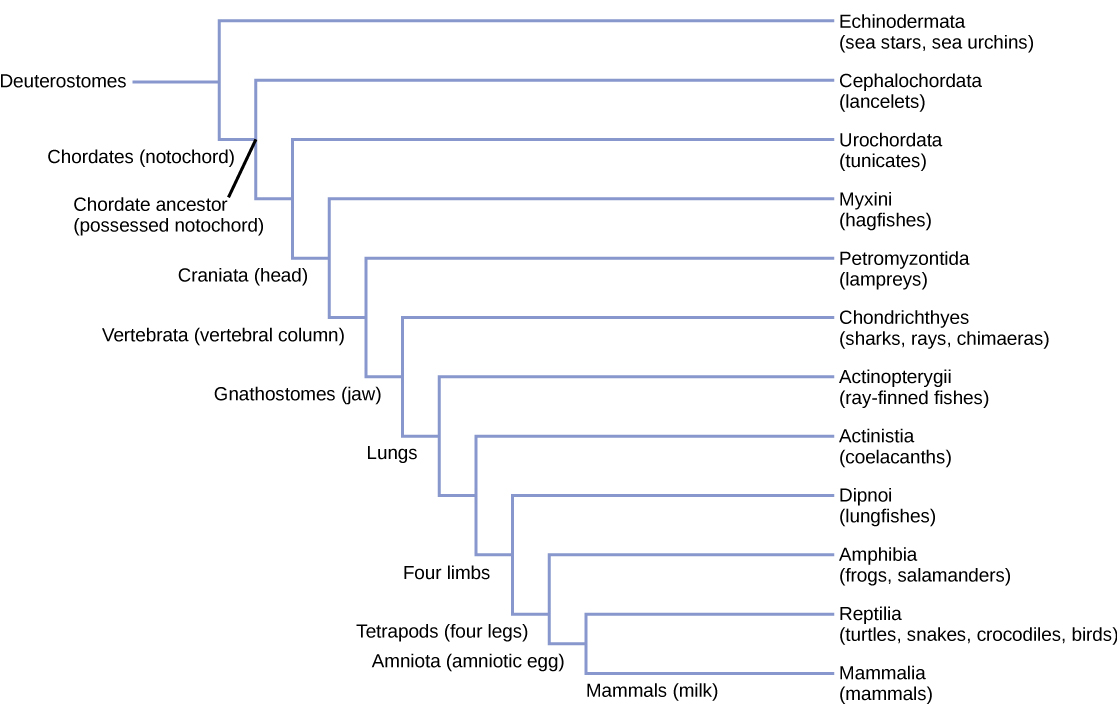
By the end of this section, you will be able to:
Vertebrates are members of the kingdom Animalia and the phylum Chordata ([link]). Recall that animals that possess bilateral symmetry can be divided into two groups—protostomes and deuterostomes—based on their patterns of embryonic development. The deuterostomes, whose name translates as “second mouth,” consist of two phyla: Chordata and Echinodermata. Echinoderms are invertebrate marine animals that have pentaradial symmetry and a spiny body covering, a group that includes sea stars, sea urchins, and sea cucumbers. The most conspicuous and familiar members of Chordata are vertebrates, but this phylum also includes two groups of invertebrate chordates.

Animals in the phylum Chordata share four key features that appear at some stage during their development: a notochord, a dorsal hollow nerve cord, pharyngeal slits, and a post-anal tail ([link]). In some groups, some of these are present only during embryonic development.
The chordates are named for the notochord, which is a flexible, rod-shaped structure that is found in the embryonic stage of all chordates and in the adult stage of some chordate species. It is located between the digestive tube and the nerve cord, and provides skeletal support through the length of the body. In some chordates, the notochord acts as the primary axial support of the body throughout the animal’s lifetime. In vertebrates, the notochord is present during embryonic development, at which time it induces the development of the neural tube and serves as a support for the developing embryonic body. The notochord, however, is not found in the postnatal stage of vertebrates; at this point, it has been replaced by the vertebral column (that is, the spine).
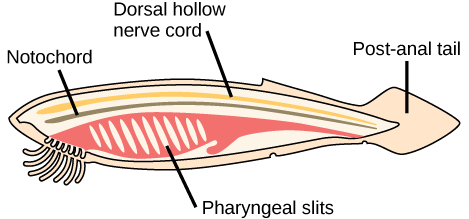
Which of the following statements about common features of chordates is true?
The dorsal hollow nerve cord derives from ectoderm that rolls into a hollow tube during development. In chordates, it is located dorsal to the notochord. In contrast, other animal phyla are characterized by solid nerve cords that are located either ventrally or laterally. The nerve cord found in most chordate embryos develops into the brain and spinal cord, which compose the central nervous system.
Pharyngeal slits are openings in the pharynx (the region just posterior to the mouth) that extend to the outside environment. In organisms that live in aquatic environments, pharyngeal slits allow for the exit of water that enters the mouth during feeding. Some invertebrate chordates use the pharyngeal slits to filter food out of the water that enters the mouth. In vertebrate fishes, the pharyngeal slits are modified into gill supports, and in jawed fishes, into jaw supports. In tetrapods, the slits are modified into components of the ear and tonsils. Tetrapod literally means “four-footed,” which refers to the phylogenetic history of various groups that evolved accordingly, even though some now possess fewer than two pairs of walking appendages. Tetrapods include amphibians, reptiles, birds, and mammals.
The post-anal tail is a posterior elongation of the body, extending beyond the anus. The tail contains skeletal elements and muscles, which provide a source of locomotion in aquatic species, such as fishes. In some terrestrial vertebrates, the tail also helps with balance, courting, and signaling when danger is near. In humans, the post-anal tail is vestigial, that is, reduced in size and nonfunctional.
Chordata also contains two clades of invertebrates: Urochordata and Cephalochordata. Members of these groups also possess the four distinctive features of chordates at some point during their development.
Members of Urochordata are also known as tunicates ([link]). The name tunicate derives from the cellulose-like carbohydrate material, called the tunic, which covers the outer body of tunicates. Although adult tunicates are classified as chordates, they do not have a notochord, a dorsal hollow nerve cord, or a post-anal tail, although they do have pharyngeal slits. The larval form, however, possesses all four structures. Most tunicates are hermaphrodites. Tunicate larvae hatch from eggs inside the adult tunicate’s body. After hatching, a tunicate larva swims for a few days until it finds a suitable surface on which it can attach, usually in a dark or shaded location. It then attaches via the head to the surface and undergoes metamorphosis into the adult form, at which point the notochord, nerve cord, and tail disappear.

Most tunicates live a sessile existence on the ocean floor and are suspension feeders. The primary foods of tunicates are plankton and detritus. Seawater enters the tunicate’s body through its incurrent siphon. Suspended material is filtered out of this water by a mucous net (pharyngeal slits) and is passed into the intestine via the action of cilia. The anus empties into the excurrent siphon, which expels wastes and water. Tunicates are found in shallow ocean waters around the world.
Members of Cephalochordata possess a notochord, dorsal hollow nerve cord, pharyngeal slits, and a post-anal tail in the adult stage ([link]). The notochord extends into the head, which gives the subphylum its name. Extinct members of this subphylum include Pikaia, which is the oldest known cephalochordate. Pikaia fossils were recovered from the Burgess shales of Canada and dated to the middle of the Cambrian age, making them more than 500 million years old.
Extant members of Cephalochordata are the lancelets, named for their blade-like shape. Lancelets are only a few centimeters long and are usually found buried in sand at the bottom of warm temperate and tropical seas. Like tunicates, they are suspension feeders.
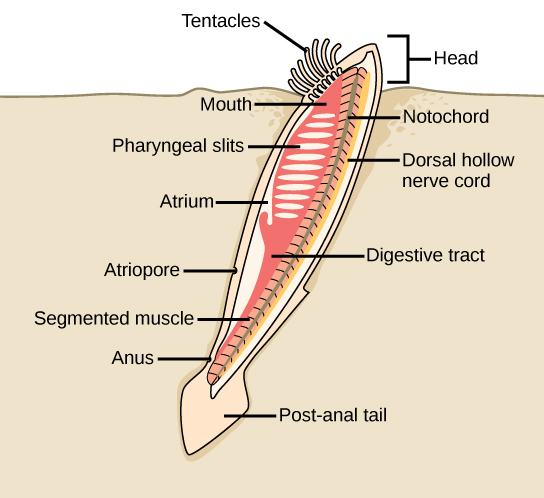
A cranium is a bony, cartilaginous, or fibrous structure surrounding the brain, jaw, and facial bones ([link]). Most bilaterally symmetrical animals have a head; of these, those that have a cranium compose the clade Craniata. Craniata includes the hagfishes (Myxini), which have a cranium but lack a backbone, and all of the organisms called “vertebrates.”
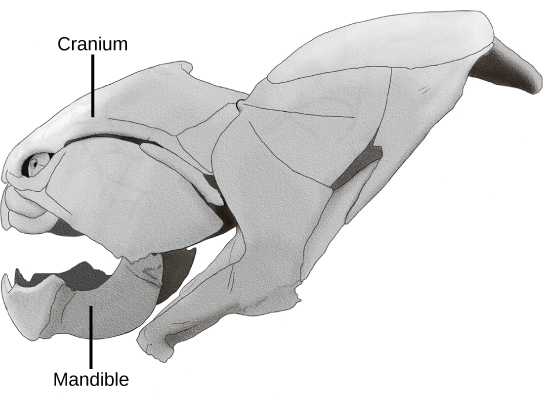
Vertebrates are members of the clade Vertebrata. Vertebrates display the four characteristic features of the chordates; however, members of this group also share derived characteristics that distinguish them from invertebrate chordates. Vertebrata is named for the vertebral column, composed of vertebrae, a series of separate bones joined together as a backbone ([link]). In adult vertebrates, the vertebral column replaces the notochord, which is only seen in the embryonic stage.
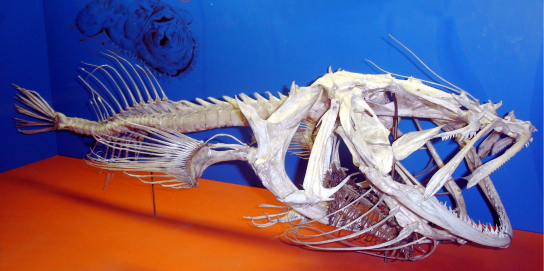
Based on molecular analysis, vertebrates appear to be more closely related to lancelets (cephalochordates) than to tunicates (urochordates) among the invertebrate chordates. This evidence suggests that the cephalochordates diverged from Urochordata and the vertebrates subsequently diverged from the cephalochordates. This hypothesis is further supported by the discovery of a fossil in China from the genus Haikouella. This organism seems to be an intermediate form between cephalochordates and vertebrates. The Haikouella fossils are about 530 million years old and appear similar to modern lancelets. These organisms had a brain and eyes, as do vertebrates, but lack the skull found in craniates.1 This evidence suggests that vertebrates arose during the Cambrian explosion. Recall that the “Cambrian explosion” is the name given to a relatively brief span of time during the Cambrian period during which many animal groups appeared and rapidly diversified. Most modern animal phyla originated during the Cambrian explosion.
Vertebrates are the largest group of chordates, with more than 62,000 living species. Vertebrates are grouped based on anatomical and physiological traits. More than one classification and naming scheme is used for these animals. Here we will consider the traditional groups Agnatha, Chondrichthyes, Osteichthyes, Amphibia, Reptilia, Aves, and Mammalia, which constitute classes in the subphylum Vertebrata. Many modern authors classify birds within Reptilia, which correctly reflects their evolutionary heritage. We consider them separately only for convenience. Further, we will consider hagfishes and lampreys together as jawless fishes, the agnathans, although emerging classification schemes separate them into chordate jawless fishes (the hagfishes) and vertebrate jawless fishes (the lampreys).
Animals that possess jaws are known as gnathostomes, which means “jawed mouth.” Gnathostomes include fishes and tetrapods—amphibians, reptiles, birds, and mammals. Tetrapods can be further divided into two groups: amphibians and amniotes. Amniotes are animals whose eggs are adapted for terrestrial living, and this group includes mammals, reptiles, and birds. Amniotic embryos, developing in either an externally shed egg or an egg carried by the female, are provided with a water-retaining environment and are protected by amniotic membranes.
The characteristic features of Chordata are a notochord, a dorsal hollow nerve cord, pharyngeal slits, and a post-anal tail. Chordata contains two clades of invertebrates: Urochordata (tunicates) and Cephalochordata (lancelets), together with the vertebrates in Vertebrata. Most tunicates live on the ocean floor and are suspension feeders. Lancelets are suspension feeders that feed on phytoplankton and other microorganisms. Vertebrata is named for the vertebral column, which is a feature of almost all members of this clade.
[link] Which of the following statements about common features of chordates is true?
[link] A
Which of the following is not contained in phylum Chordata?
B
Which group of invertebrates is most closely related to vertebrates?
A
What are the characteristic features of the chordates?
The characteristic features of the phylum Chordata are a notochord, a dorsal hollow nerve cord, pharyngeal slits, and a post-anal tail.

You can also download for free at http://cnx.org/contents/185cbf87-c72e-48f5-b51e-f14f21b5eabd@11.2
Attribution: